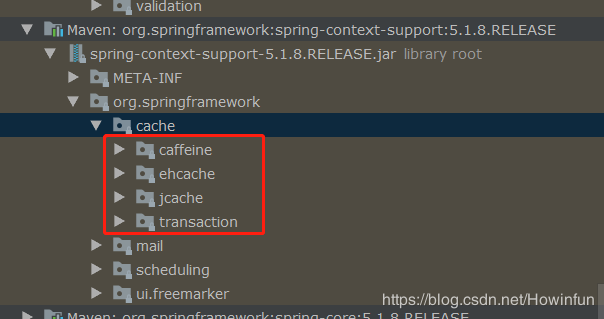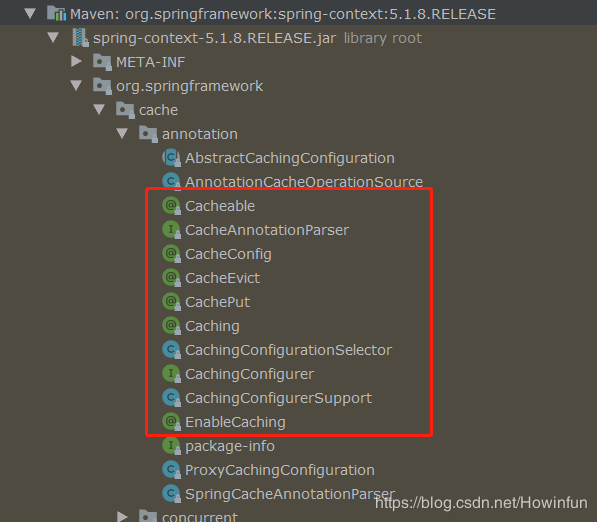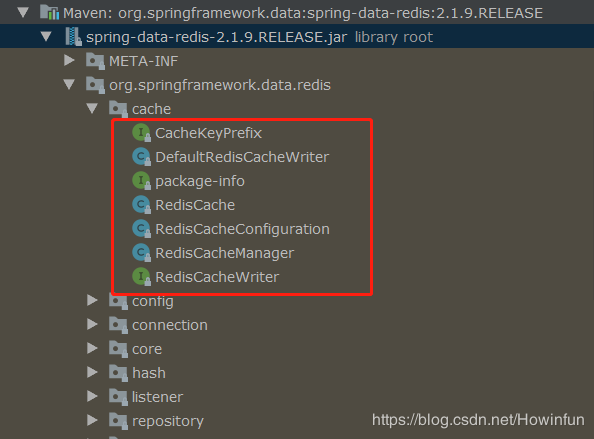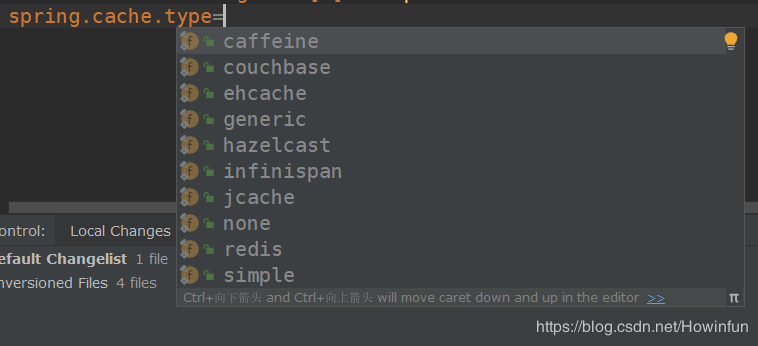【开源项目系列】如何基于 Spring Cache 实现多级缓存(同时整合本地缓存 Ehcache 和分布式缓存 Redis)
一、缓存
当系统的并发量上来了,如果我们频繁地去访问数据库,那么会使数据库的压力不断增大,在高峰时甚至可以出现数据库崩溃的现象。所以一般我们会使用缓存来解决这个数据库并发访问问题,用户访问进来,会先从缓存里查询,如果存在则返回,如果不存在再从数据库里查询,最后添加到缓存里,然后返回给用户,当然了,接下来又能使用缓存来提供查询功能。
而缓存,一般我们可以分为本地缓存和分布式缓存。
常用的本地缓存有 ehcache、guava cache,而我们一般都是使用 ehcache,毕竟他是纯 Java 的,出现问题我们还可以根据源码解决,并且还能自己进行二次开发来扩展功能。
常用的分布式缓存当然就是 Redis 了,Redis 是基于内存和单线程的,执行效率非常的高。
二、Spring Cache
相信如果要整合缓存到项目中,大家都会使用到 Spring Cache,它不但整合了多种缓存框架(ehcache、jcache等等),还可以基于注解来使用,是相当的方便。
缓存框架的整合在 spring-context-support 中:

缓存注解在 spring-context 中:

当然了,在 Spring 的 context 中没有整合 Redis,但是我们可以在 spring-data-redis 中找到。

但是我们都知道,不管是在 Spring 项目 还是 Spring Boot 中,我们都只能整合一种缓存,不能同时整合多种缓存。
在 Spring Boot 中,我们一般是利用 spring.cache.type 来指定使用哪种缓存,然后填写相关配置信息来完成自动配置。

CacheType 的源码:我们可以看到,Spring 是支持非常多种缓存框架的。
package org.springframework.boot.autoconfigure.cache;
public enum CacheType {
GENERIC,
JCACHE,
EHCACHE,
HAZELCAST,
INFINISPAN,
COUCHBASE,
REDIS,
CAFFEINE,
SIMPLE,
NONE;
private CacheType() {
}
}
那么如果我们就是有这么一种需求,要整合两种缓存框架:例如一个本地缓存 Ehcache,一个分布式缓存 Redis,
那能整么?
能是能,但是 Spring 可不提供这种多级缓存,而是需要你自己动手来整了。
三、h2cache-spring-boot-starter
1、什么是 h2cache-spring-boot-starter?
在微服务中,每个服务都是无状态的,服务之间需要经过 HTTP 或者 RPC 来进行通信。而每个服务都拥有自己对应的数据库,所以说如果服务A 需要获取服务B 的某个表的数据,那么就需要一次 HTTP 或 RPC 通信,那如果高峰期每秒需要调用100次,那岂不是需要100次 HTTP 或 RPC 通信,这是相当耗费接口性能的。
那怎么解决呢?
本地缓存那是肯定不是的,因为一般不同服务都是部署在不同的机器上面的,所以此时我们需要的是分布式缓存,例如 Redis;但是,访问量高的的服务当然还是需要本地缓存了。所以最后,我们不但需要本地缓存,还需要分布式缓存,但是 Spring Boot 却不能提供这种多级缓存的功能,所以需要我们自己来整合。
不用怕,我已经自己整了一个 Spring Boot Starter了,就是 h2cache-spring-boot-starter ,我们只需要在配置文件配置上对应的信息,就可以启用这个多级缓存的功能了。
2、开始使用
添加依赖:
大家正常引入下面依赖即可,因为我已经将此项目发布到 Maven 中央仓库了~
<denpency>
<groupId>com.github.howinfun</groupId>
<artifactId>h2cache-spring-boot-starter</artifactId>
<version>0.0.1</version>
</denpency>
在 Spring Boot properties 启用服务,并且加上对应的配置:
开启多级缓存服务:
# Enable L2 cache or not h2cache.enabled=true
配置 Ehcache:
# Ehcache Config ## the path of ehcache.xml (We can put it directly under Resources) h2cache.ehcache.filePath=ehcache.xml #Set whether the EhCache CacheManager should be shared (as a singleton at the ClassLoader level) or independent (typically local within the application).Default is "false", creating an independent local instance. h2cache.ehcache.shared=true
配置 Redis:主要包括默认的缓存配置和自定义缓存配置
要注意一点的是:h2cache-spring-boot-starter 同时引入了 Lettuce 和 Jedis 客户端,而 Spring Boot 默认使用 Lettuce 客户端,所以如果我们需要使用 Jedis 客户端,需要将 Lettuce 依赖去除掉。
# Redis Config
## default Config (expire)
h2cache.redis.default-config.ttl=200
### Disable caching {@literal null} values.Default is "false"
h2cache.redis.default-config.disable-null-values=true
### Disable using cache key prefixes.Default is "true"
h2cache.redis.default-config.use-prefix=true
## Custom Config list
### cacheName -> @CacheConfig#cacheNames @Cacheable#cacheNames and other comments, etc
h2cache.redis.config-list[0].cache-name=userCache
h2cache.redis.config-list[0].ttl=60
h2cache.redis.config-list[0].use-prefix=true
h2cache.redis.config-list[0].disable-null-values=true
h2cache.redis.config-list[1].cache-name=bookCache
h2cache.redis.config-list[1].ttl=60
h2cache.redis.config-list[1].use-prefix=true
#Redis
spring.redis.host=10.111.0.111
spring.redis.password=
spring.redis.port=6379
spring.redis.database=15
# 连接池最大连接数(使用负值表示没有限制)
spring.redis.jedis.pool.max-active=8
# 连接池中的最小空闲连接
spring.redis.jedis.pool.min-idle=0
# 连接池中的最大空闲连接
spring.redis.jedis.pool.max-idle=8
# 连接池最大阻塞等待时间(使用负值表示没有限制)
spring.redis.jedis.pool.max-wait=30
如何使用缓存注解
我们只要像之前一样使用 Spring Cache 的注解即可。
for example:
代码里的持久层,我使用的是: mybatis-plus .
package com.hyf.testDemo.redis;
import com.baomidou.mybatisplus.core.mapper.BaseMapper;
import org.springframework.cache.annotation.CacheConfig;
import org.springframework.cache.annotation.CacheEvict;
import org.springframework.cache.annotation.CachePut;
import org.springframework.cache.annotation.Cacheable;
import org.springframework.cache.annotation.Caching;
import org.springframework.stereotype.Repository;
/**
* @author Howinfun
* @desc
* @date 2020/3/25
*/
@Repository
// Global cache config,We usually set the cacheName
@CacheConfig(cacheNames = {"userCache"})
public interface UserMapper extends BaseMapper<User> {
/**
* put the data to cache(Ehcache & Redis)
* @param id
* @return
*/
@Cacheable(key = "#id",unless = "#result == null")
User selectById(Long id);
/**
* put the data to cache After method execution
* @param user
* @return
*/
@CachePut(key = "#user.id", condition = "#user.name != null and #user.name != ''")
default User insert0(User user) {
this.insert(user);
return user;
}
/**
* evict the data from cache
* @param id
* @return
*/
@CacheEvict(key = "#id")
int deleteById(Long id);
/**
* Using cache annotations in combination
* @param user
* @return
*/
@Caching(
evict = {@CacheEvict(key = "#user.id", beforeInvocation = true)},
put = {@CachePut(key = "#user.id")}
)
default User updateUser0(User user){
this.updateById(user);
return user;
}
}
测试一下:
查询:我们可以看到,在数据库查询到结果后,会将数据添加到 Ehcache 和 Redis 缓存中;接着之后的查询都将会先从 Ehcache 或者 Redis 里查询。
2020-04-03 09:55:09.691 INFO 5920 --- [nio-8080-exec-7] com.zaxxer.hikari.HikariDataSource : HikariPool-1 - Starting... 2020-04-03 09:55:10.044 INFO 5920 --- [nio-8080-exec-7] com.zaxxer.hikari.HikariDataSource : HikariPool-1 - Start completed. 2020-04-03 09:55:10.051 DEBUG 5920 --- [nio-8080-exec-7] c.h.t.redis.BookMapper2.selectById : ==> Preparing: SELECT id,create_time,update_time,read_frequency,version,book_name FROM book WHERE id=? 2020-04-03 09:55:10.068 DEBUG 5920 --- [nio-8080-exec-7] c.h.t.redis.BookMapper2.selectById : ==> Parameters: 51(Long) 2020-04-03 09:55:10.107 DEBUG 5920 --- [nio-8080-exec-7] c.h.t.redis.BookMapper2.selectById : <== Total: 1 2020-04-03 09:55:10.113 INFO 5920 --- [nio-8080-exec-7] c.hyf.cache.cachetemplate.H2CacheCache : insert into ehcache,key:51,value:Book2(id=51, bookName=微服务架构, readFrequency=1, createTime=2020-03-20T16:10:13, updateTime=2020-03-27T09:14:44, version=1) 2020-04-03 09:55:10.118 INFO 5920 --- [nio-8080-exec-7] c.hyf.cache.cachetemplate.H2CacheCache : insert into redis,key:51,value:Book2(id=51, bookName=微服务架构, readFrequency=1, createTime=2020-03-20T16:10:13, updateTime=2020-03-27T09:14:44, version=1) 2020-04-03 09:55:31.864 INFO 5920 --- [nio-8080-exec-2] c.hyf.cache.cachetemplate.H2CacheCache : select from ehcache,key:51
删除:删除数据库中的数据后,也会删除 Ehcache 和 Redis 中对应的缓存数据。
2020-04-03 10:05:18.704 DEBUG 5920 --- [nio-8080-exec-3] c.h.t.redis.BookMapper2.deleteById : ==> Preparing: DELETE FROM book WHERE id=? 2020-04-03 10:05:18.704 DEBUG 5920 --- [nio-8080-exec-3] c.h.t.redis.BookMapper2.deleteById : ==> Parameters: 51(Long) 2020-04-03 10:05:18.731 DEBUG 5920 --- [nio-8080-exec-3] c.h.t.redis.BookMapper2.deleteById : <== Updates: 1 2020-04-03 10:05:18.732 INFO 5920 --- [nio-8080-exec-3] c.hyf.cache.cachetemplate.H2CacheCache : delete from ehcache,key:51 2020-04-03 10:05:18.844 INFO 5920 --- [nio-8080-exec-3] c.hyf.cache.cachetemplate.H2CacheCache : delete from redis,key:51
其他的就不用演示了...
四、最后
当然啦,这个 starter 还是比较简单的,如果大家感兴趣,可以去看看源码是如何基于 Spring Cache 实现多级缓存的~
- 本文标签: 开发 Word 分布式 源码 Ipo UI App mybatis 删除 Spring Boot 测试 tar 配置 时间 list http id 部署 ssl https map 需求 value core IO 并发 update git HBase 代码 key src NIO 微服务 java ip cat GitHub example cache 缓存 spring 压力 开源项目 XML dataSource mapper 连接池 maven 线程 redis Select 开源 ACE bug tab 数据库 数据 HTML
- 版权声明: 本文为互联网转载文章,出处已在文章中说明(部分除外)。如果侵权,请联系本站长删除,谢谢。
- 本文海报: 生成海报一 生成海报二











![[HBLOG]公众号](https://www.liuhaihua.cn/img/qrcode_gzh.jpg)

